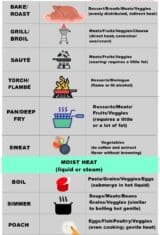There are 3 types of cooking methods that you should know about as a home cook: dry heat cooking, moist heat cooking, and combination cooking. Each of these uses heat and different cooking techniques to cook food in different ways and obtain different results. Once you learn these basic cooking methods, you’ll be ready to cook almost anything!
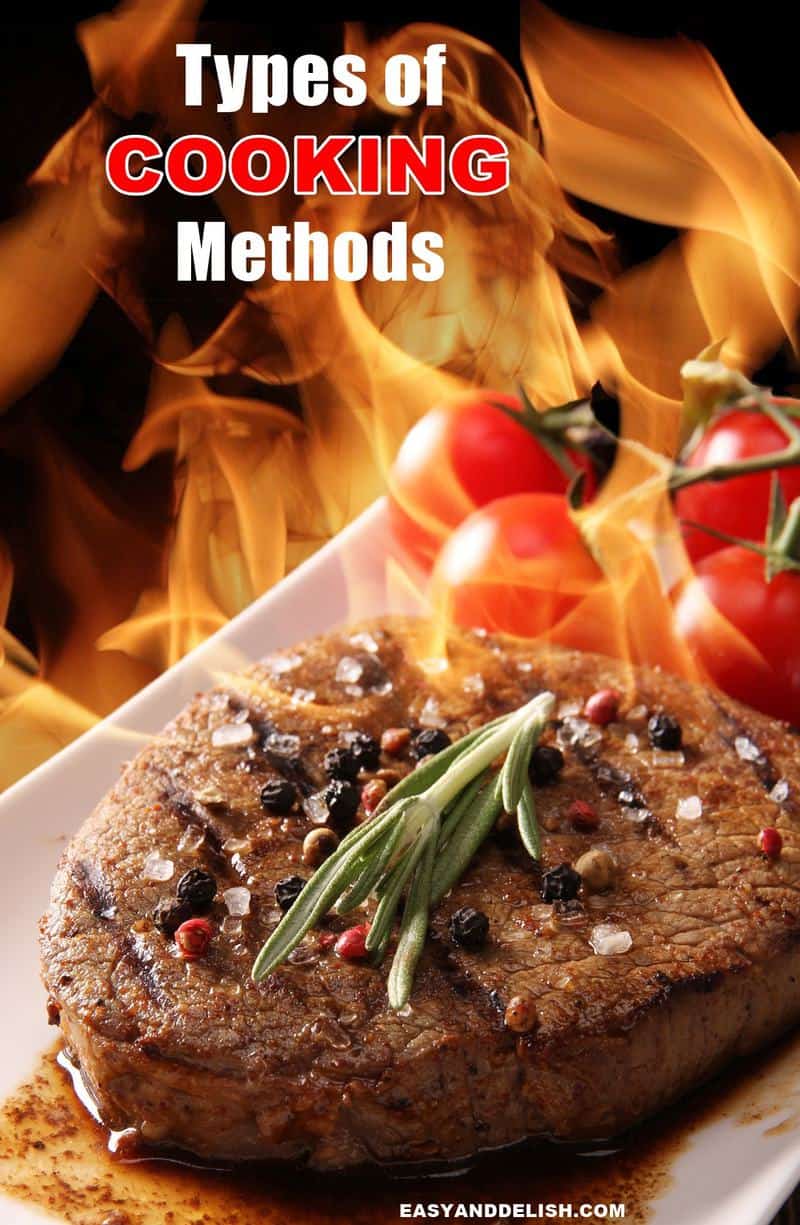
Table of Contents
Dry Heat Cooking vs. Moist Heat Cooking
To begin we’re going to really dig into two important cooking methods to know: dry heat cooking and moist heat cooking (or wet heat cooking). There are many different types of cooking that fall under these two categories, so we’ll explore them each in-depth and talk about the types of foods that are best for each of these methods.
We’ll also talk about combination cooking, the healthiest cooking methods, and more. Understanding all of the basic cooking techniques will allow you to work with a variety of ingredients and achieve really good, consistent, flavorful results. Most of these methods of cooking produce dishes that are easy freezer meals.
1. Dry Heat Cooking Methods
Dry heat cooking is a cooking method without any added moisture, such as water or broth. This technique relies on the circulation of hot air or direct contact with the food to transfer enough heat to the food to cook it thoroughly.
With temperatures of 300 degrees or higher, the foods can brown and intensify in flavor. Browning is a heat reaction when the sugars and acids in the food turn brown, which creates a really delicious flavor.
There are five main dry heat cooking methods that are important to know: baking, roasting, broiling, sautéing, and grilling. But frying such as deep-frying and pan-frying are also dry cooking techniques, relying on fat and high temps to cook the food. Oil is fat and although it is a liquid, it's listed as a dry-heat cooking because it doesn't involve water or a broth.
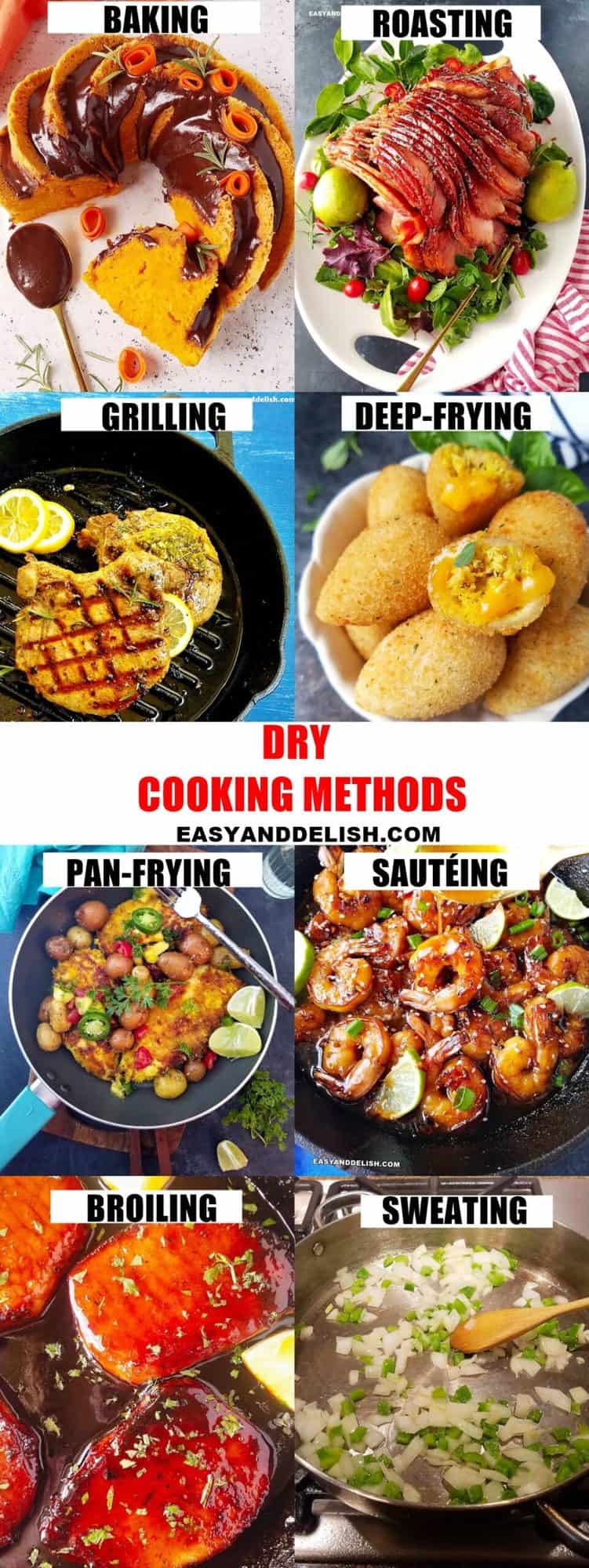
Baking
This cooking method uses indirect heat that surrounds foods to cook them from all sides. Baking and roasting are very similar, but baking is the term usually used when cooking foods such as bread, cake, cookies, etc. In contrast, roasting might typically be used when baking foods like vegetables and meats. The techniques are almost the same, except baking is often accomplished with lower temperatures than roasting.
Best foods for baking:
- Breads
- Cakes
- Cookies
- Pastries
- Pizza
- Pies
Baking is a great cooking method because it cooks food evenly at a consistent temperature.
Recipes:
Roasting
Roasting is similar to baking in that the method uses indirect heat that cooks the food from all sides. It can be done at low temperatures as low as 200F degrees, up to the commonly used medium heat of 350° F. Or roasting can be done at even higher temperatures up to 450°F. The temperature will depend on the food you’re roasting.
Best foods for roasting:
- Large cuts of meat, such as beef tenderloin, prime rib, crown roast, ribs, pork shoulder or butt, pork loin, etc.
- Whole chicken, turkey, or fish
- Vegetables, such as potatoes, green beans, broccoli, carrots, squash, eggplant, cauliflower, etc.
- Fruits, such as tomatoes, cherries, grapes, peaches, etc.
Roasting is a great cooking method because it creates browning and intensifies the flavors of foods.
Recipes:
Broiling
Broiling works by transferring very high heat to food and causing browning to happen quickly, sealing in the flavor and moisture inside the food, and giving it a nicely browned and crisp exterior. Because of the high direct heat, you’ll want to watch food closely, so that it doesn’t burn. Broiling is usually only done for a few minutes at the most and sometimes is used after the food is already cooked through using a different method, such as baking. At home, you’ll most likely be using your oven's broil function, but in restaurants they often use a special oven called a salamander to broil food.
Best foods for broiling:
- Meats – this method is usually best for the most tender cuts of meat.
- Fish, such as salmon or other thick cuts of fish that won’t dry out easily.
- Poultry, such as chicken or turkey breast, thighs, wings, or legs.
- Vegetables
- Fruits
Broiling is a great cooking method because it cooks quickly, seals flavor inside the food, and browns very well.
Recipes:
Sauteing
Sauteing is done over a burner on your stove in a shallow pan. To sauté foods you’ll need to use a small amount of oil or fat to coat food—this prevents the food from sticking to the pan and is good for even browning. This cooking method usually cooks foods quickly and you’ll need to flip the food halfway through the cooking time.
The word sauté comes from a French word that means "jump," which really makes sense if you sprinkle a drop of water onto the hot pan and watch it literally jump. Sweating is similar to sauteing because is a dry cooking method that involves a little amount of fat to cook the food. But unlike sauteing, it requires frequent stirring and is good to extract flavor from vegetables such as onions, cooking them until they become tender and translucent, not brown. The food is cooked over medium heat instead of medium-high!
Best foods for sauteing:
- Meats, such as bacon and ground beef (hamburgers, crumbled ground beef, etc.), steaks, etc.
- Poultry, such as chicken or turkey filets
- Vegetables, such as leafy greens, green beans, carrots, onions, peppers, zucchini, asparagus, etc.
Sautéing is a great cooking method because it gives the cook good control over the food, it cooks quickly, and can be used to cook a variety of foods.
Recipes:
Grilling
Grilling uses radiant heat to cook foods over an open grate with a heat source (usually charcoal or a gas flame) beneath the food. Many people enjoy the natural flavors infused into the food from the heat source and from flavored wood chips that can be used during grilling.
Best foods for grilling:
- Meats, such as steaks that have a high-fat content and produce a tender, flavorful grilled steak. The best steaks for grilling are ribeye, T-bone, New York strip, and porterhouse.
- Poultry, such as chicken.
- Fish – be sure to use a sturdy fish that won’t dry out on the grill or fall apart when you flip the fish. You may need to place your fish on an oiled piece of foil, or a wooden plank made for grilling.
- Burgers, hot dogs, bratwurst (“brats”), sausage
- Vegetables, such as corn on the cob, onions, peppers, potatoes, zucchini, etc.
- Fruits, such as fresh pineapple or peaches. Several traditional Brazilian foods such as churrasco use grilling for cooking.
Recipes:
Pro tip: marinate your meat! Marination is the process of soaking foods in a seasoned, often acidic, liquid before cooking. In addition to these ingredients, a marinade often contains oils, herbs, and spices to further flavor the food items. It is commonly used to flavor foods and to tenderize tougher cuts of meat.
Grilling is a great cooking method because it can be quick and infuses so much flavor into foods. It can also be an enjoyable process since grills are usually located outside, making grilling feel more like a leisurely activity than a cooking chore.
Frying Methods
Frying is a common way of cooking many foods that we love. There are two main frying methods that you should know: pan-frying and deep-frying.
Pan Frying
Pan-frying is cooking food in a hot pan with enough fat that it comes up about half an inch up the side of the pan, partially submerging the food in the fat. During pan-frying, the food must be flipped halfway through the cooking.
Best foods for pan-frying:
- Meats, usually coated in a breading, like fried chicken or country fried steak, or these pan-fried pork chops.
- Fish, such as crab cakes.
- Batter-dipped foods
- Some vegetables, such as these pan-fried collard greens
Pan-frying is a great method of cooking foods, especially those coated in a batter to cause them to become crispy.
Deep Frying
Deep-frying is when food is totally submerged in hot oil. The result is that the food fully cooks inside while the exterior becomes crispy and golden brown.
Best foods for deep frying:
- French fries
- Batter-coated meats, such as country-fried steak.
- Pastries, such as donuts.
- Batter-coated poultry, such as fried chicken tenders or nuggets.
- Batter-coated fish and pastries such as these Brazilian chicken fritters and rissoles
Deep frying is a great cooking method for creating delicious, crispy, flavorful foods, although it is one of the least healthy ways of cooking due to the amount of oil used.
2. Moist Heat Cooking Methods
Moist or wet heat cooking requires liquid or steam to cook foods. This method can be used to make lower-fat foods or to tenderize tough cuts of meat, such as brisket or beef chuck roast.
Moist heat is essential when cooking fibrous vegetables, rice, and legumes (beans) to make them tender. While dry cooking methods usually produce browning, moist/wet cooking methods will not.
There are four main moist heat cooking methods that are important to know: boiling, simmering, poaching, and steaming. But sous-vide (greatly used by high-end restaurants) and microwaving (popular among home cooks) are also types of moist cooking!
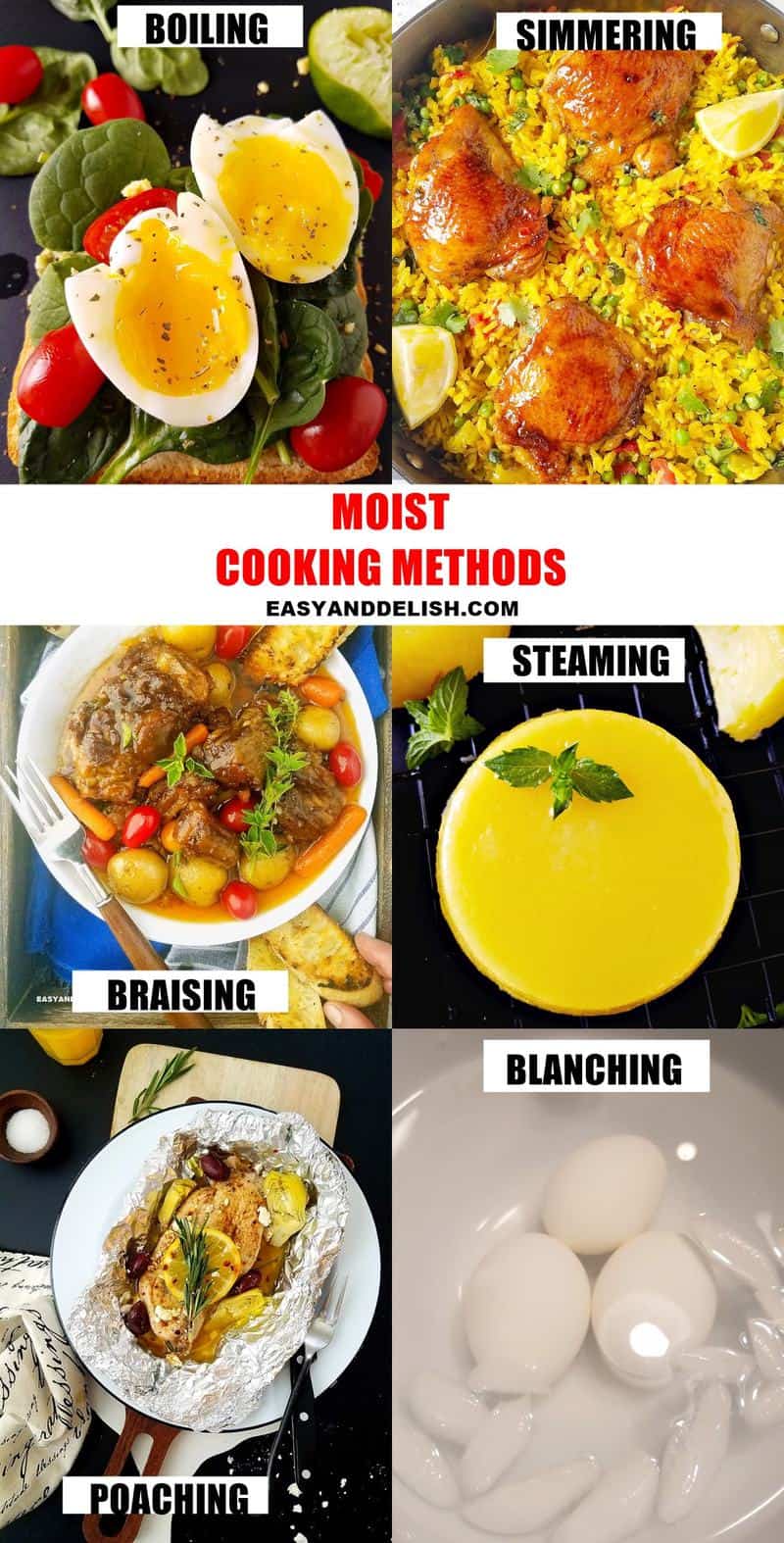
Boiling
Boiling is a cooking method that involves submerging food in very hot water to cook. Water boils at 212° F. As the water boils, it creates bubbles and movement in the water which also keeps the food in motion, leading to even cooking. This method also imparts a lot of moisture into the food, but it can also strip away some of the nutrients.
Best foods for boiling:
- Pasta
- Eggs, such as soft or hard boiled eggs.
- Vegetables, such as very firm root vegetables like potatoes and carrots.
Boiling is a good cooking method for tough or dry foods. Blanching is a wet cooking method that involves boiling a vegetable or fruit in water briefly and then plunge into ice water to halt the cooking process. It can be used before freezing vegetables or to easily peel a tomato for example. But boiled eggs can also be blanched in iced water or cold running water to easily remove the peel and stop the cooking process.
Simmering
Simmering is similar to boiling but much gentler. Simmer is usually achieved between 180°F degrees and 205°F degrees, just below the boiling point of water. The best way to get to the simmering point is to bring water up to boiling and then lower the temperature until it is just simmering.
Best foods for simmering:
- Meats – tough cuts of meat might do well to simmer in liquid (such as broth or a sauce) over low heat for a long period of time until they become tender.
- Poultry
- Rice
- Soups such as this Norwegian fish soup, broths, and stocks.
- Grains, such as oats or quinoa.
- Vegetables, such as tough root vegetables.
- Beans and legumes – sometimes beans will need to soak in water for hours before simmering, such as our black beans.
Simmering is a good cooking method because it cooks tough foods slowly, allowing them to soften and become tender.
Poaching
Poaching is one of the gentlest methods of cooking. You’ll submerge in hot liquid to cook gently. The temperatures usually range between 140°F degrees and 180°F degrees. This low heat works really well for very delicate foods, cooking them evenly and adding or preserving the food’s natural moisture.
Best foods for poaching:
- Eggs – poaching eggs is a very healthy alternative to pan-frying.
- Fish, such as cod, tilapia, or sole.
- Poultry, such as chicken or turkey.
- Fruit, such as apples, pears, and these poached peaches.
Poaching is a wonderful cooking method that allows you to very gently cook delicate foods. You can also impart additional flavors by using poaching liquids such as broth, juice, or wine.
Steaming
Steaming food is accomplished by placing it above boiling water that produces steam hot enough to cook the food. This method helps the food retain moisture and nutrients while also tenderizing the food.
Steaming can be done using an electric food steamer, a pot of boiling water, and a steaming basket, in the microwave, or by wrapping foods in foil packets so they will steam in the oven or on the grill ("en papillote"). Moreover, you can steam foods in the pressure cooker such as this Instant Pot whole chicken.
Find out more about how to use a pressure cooker to steam your foods!
Best foods for steaming:
- Fish and shellfish
- Vegetables such as corn on the cob
- Tamales
- Some types of couscous such as this cuscuz de milho
- Desserts, such as panna cotta, crème brulée, this pumpkin flan, and other custards such as brigadeirao.
Steaming is a great cooking method as it requires no added fats, imparts moisture into the foods, and does not wash away nutrients the way boiling can. It makes a great way to conserve nutrients!
Sous Vide
Sous vide is a method of cooking that slowly cooks food for a very long time at low temperatures. The term “sous vide” is French and means “under vacuum.”
With the sous vide method, you’ll place food in an airtight plastic bag and then cook the food in the bags in water that is hot but well below boiling point. Because of the low water temperature, the food takes hours and even up to a day to come up to the fully cooked temperature.
Best foods for sous vide:
- Meats (in fact, you can sous vide several cuts of beef)
- Fish
- Poultry
- Eggs such as these keto Starbucks egg bites
- Vegetables
Sous vide is a great cooking method for producing consistent, restaurant-quality foods.
Microwave Cooking
You can bake or roast some foods in a microwave. This method of cooking is also great for reheating leftover foods.
Do be aware that the microwave works to cook food by adding energy to the water and fat molecules, literally cooking food from the inside out. This means that the outside of the food will not brown or crisp, so this cooking method is not ideal for all foods.
Best foods to microwave:
- Frozen foods, such as frozen dinners and vegetables.
- Baked potatoes
- Oatmeal
- Mug cakes such as this peanut butter mug cake and chocolate cake in a mug.
- Eggs – eggs can be poached or scrambled eggs cooked in a coffee mug.
- Pre-cooked foods – microwaves are best known for easily reheating leftover foods.
- Small pasta such as our microwave mac and cheese.
Microwave cooking is a great method to cook simple foods or reheat meals. Print our cooking method chart below for dry and moist heat cooking!
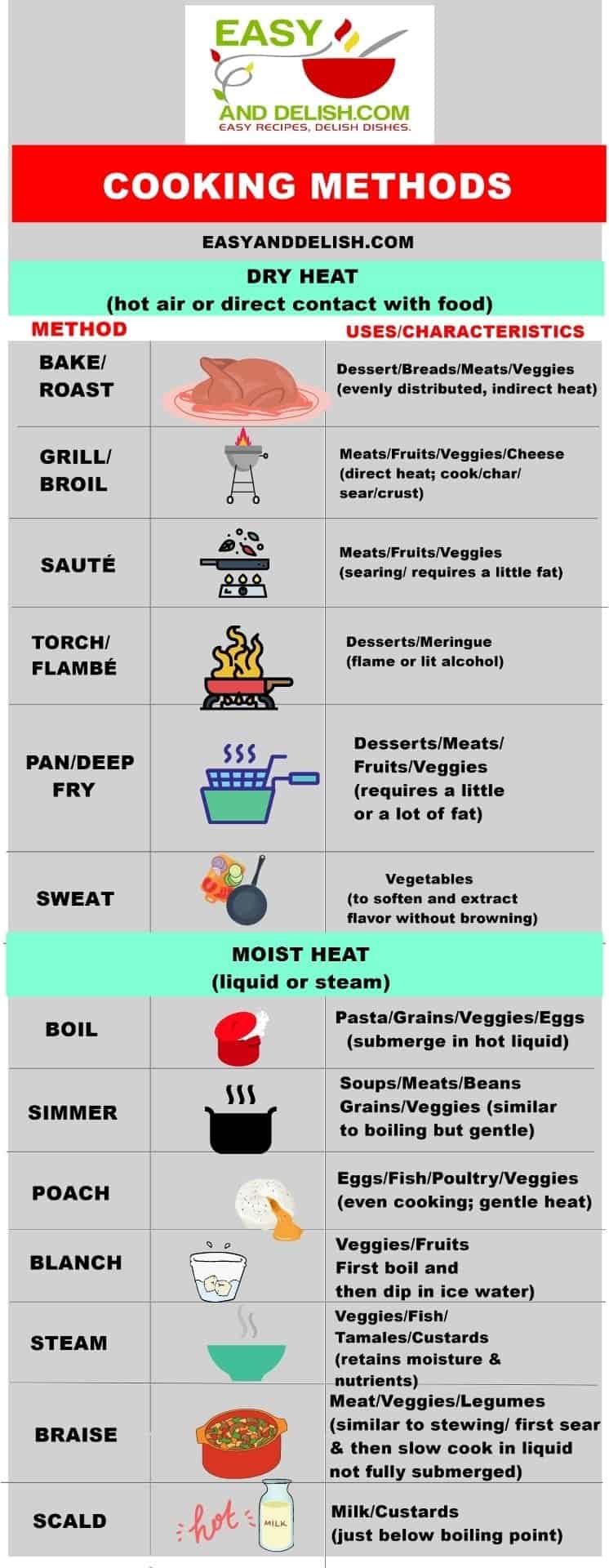
3. Combination Cooking Methods
Combination cooking uses both dry and wet methods of cooking at the same time. Foods are cooked with added moisture at a low temperature for a long time. This cooking method creates fork-tender foods, even from the toughest cuts of meat and most firm vegetables.
There are two main combination cooking methods that are important to know: stewing and braising.
Stewing
When stewing foods, you’ll completely submerge them in liquid and cook at low temperatures for a long period of time. This causes fibrous vegetables to break down, and causes the fat and collagen in tough cuts of meats to melt. Stewing foods creates a wonderful gravy, sauce, or stew with tender meats and vegetables.
Best foods for stewing:
- Meats, such as chuck roast, oxtail, brisket, etc.
- Vegetables, such as onions, potatoes, carrots, parsnips, rutabaga, celery, turnips, etc.
Stewing is a great cooking method because it tenderized otherwise tough cuts of meat and vegetables and creates a flavorful sauce or gravy.
Recipes:
Braising
Braising is similar to stewing, except that the foods will not be completely submerged in liquid. Foods are first seared in a pan with oil and then moved to a larger pot with some liquid to cook in low heat for a long period of time. This cooking method produces the most fork-tender, fall-off-the-bone meats.
Best foods for braising:
- Meats, such as lamb, pork shoulder, chuck roast, etc.
- Vegetables, such as potatoes, turnips, beets, carrots, etc.
- Legumes, such as lentils, green beans, chickpeas, and braised brussels sprouts.
Braising is a wonderful cooking method for creating the most flavorful, tender foods from tough cuts of meat and from firm vegetables and legumes.
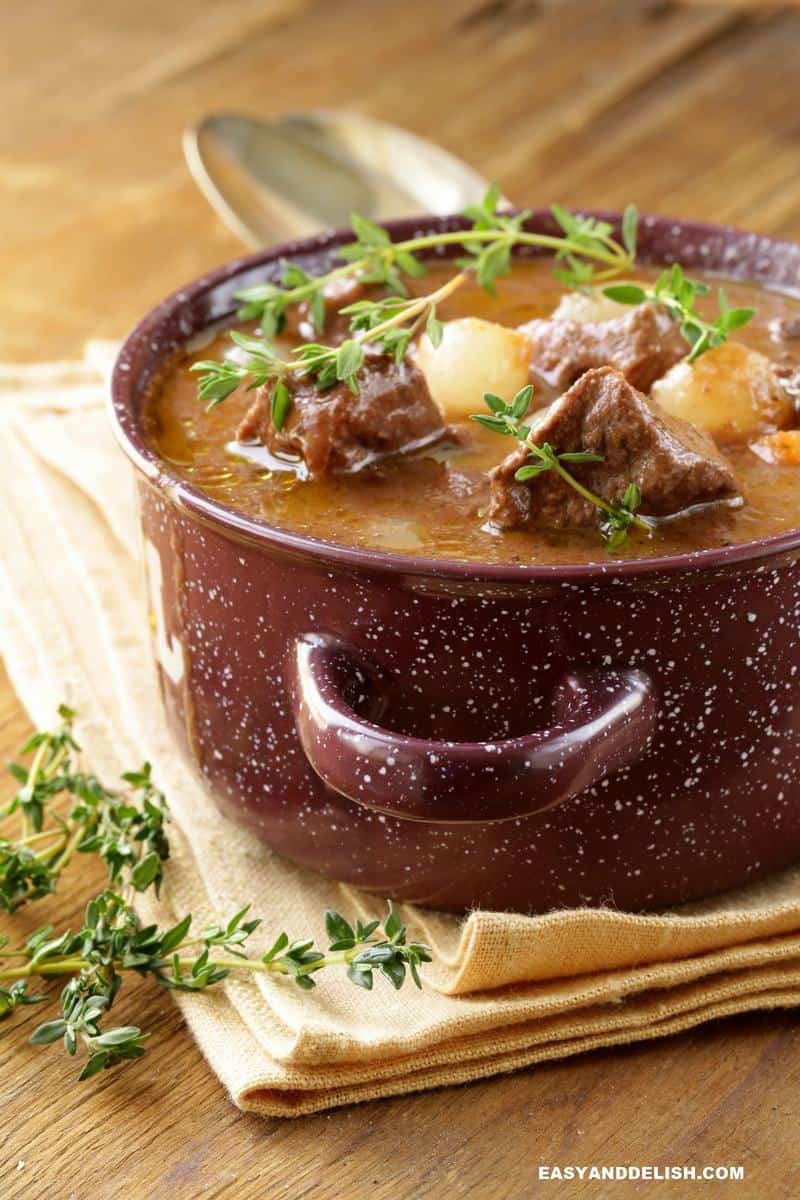
Transferring Heat to Food
Heat is energy. When the heat comes into contact with a cooler food, the energy from the heat transfers into the colder food until they both reach the same temperature. This is basically what cooking is—transfer of heat.
There are four mains ways of using heat transfer as a cooking method:
1. Conduction: This is the transfer of heat from the heat source to the food when the food comes into direct contact with the heat.
2. Convection: This is the transfer of heat that is caused by the movement of molecules from a heat source through a fluid to the food. The heat can be transferred through air, water, or fat.
3. Radiation: This cooking method does not require physical contact between the heat source and the food, but instead works through heat created by microwave and infrared waves.
4. Induction: It uses electric currents to directly and instantly heat pots and pans through magnetic induction instead of using a gas or electric heat from a burner to a pot or pan.
Healthy Cooking Methods
While all cooking methods can be considered “healthy” depending on your chosen diet (for example pan-frying is perfectly acceptable when the majority of carbohydrates are eliminated from a person’s diet in a “low-carb” diet plan), a few stand out as the best for the health-conscious:
- Poaching
- Steaming
- Grilling
- Baking
- Stewing
These cooking methods require little to no added fat and are some of the least likely to strip nutrients away from foods.
Glossary of Cooking Terms
When following recipes, it’s important to be familiar with the cooking terms you will often see. Here is a basic glossary of the most common terms (in alphabetical order):
Al Dente – pasta that is cooked until soft but still firm.
Baste – the action of pouring liquids over meat while it is cooking.
Blanch - to cook food boiling water for a very short time and then place it in cold water to stop the cooking.
Caramelize – heating the sugars in food until they are browned.
Chiffonade - rolling up herbs or greens to cut into long, thin pieces.
Clarify - melting butter and then separating the solids from the clear fat.
Cure - preserving foods by adding salt that draws out the moisture.
Deglaze – using the liquid to pull up the browned food pieces in a hot pan after sautéing.
Dredge - coating foods in a dry ingredient, such as flour.
Emulsify – blending together liquids, such as oil and water.
Fillet – a thin cut of meat or fish.
Flambé – covering food in a flammable liquid and lighting it on fire.
Fold – incorporating one ingredient (or a mixture of ingredients) into another very gently without deflating any air in the ingredients.
Spatchcock – to split open a whole chicken or turkey for easy roasting or grilling.
Julienne - cutting foods into long, thin strips.
Parboil – a method of partially cooking foods by boiling.
Reduce - thickening a liquid by boiling or simmering which causes some of the moisture to evaporate, leaving behind a thicker and more flavorful liquid.
You’re Ready to Cook!
With a basic understanding of the cooking methods and terms outlined above, you’ll be able to follow any recipe and cook all sorts of wonderful foods in your own kitchen. Be sure to pin or bookmark this article to refer to whenever you need a refresher on this helpful information.



